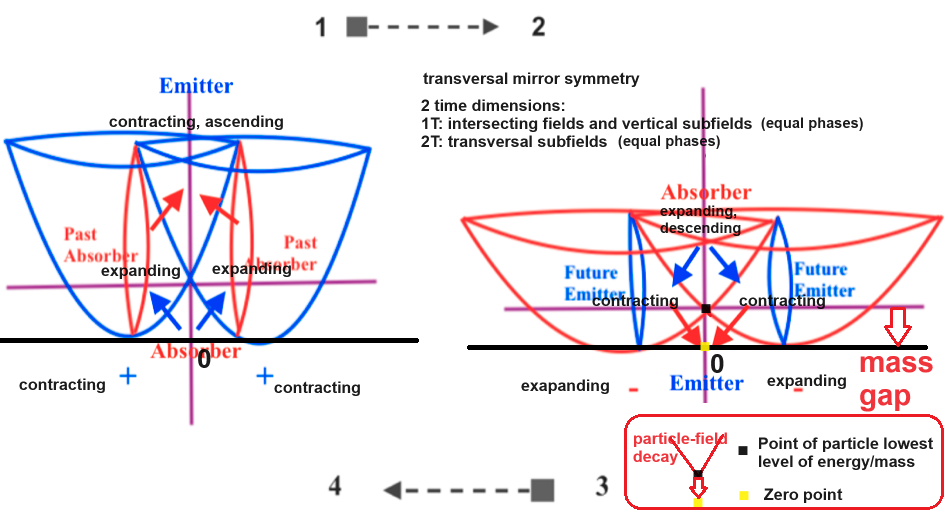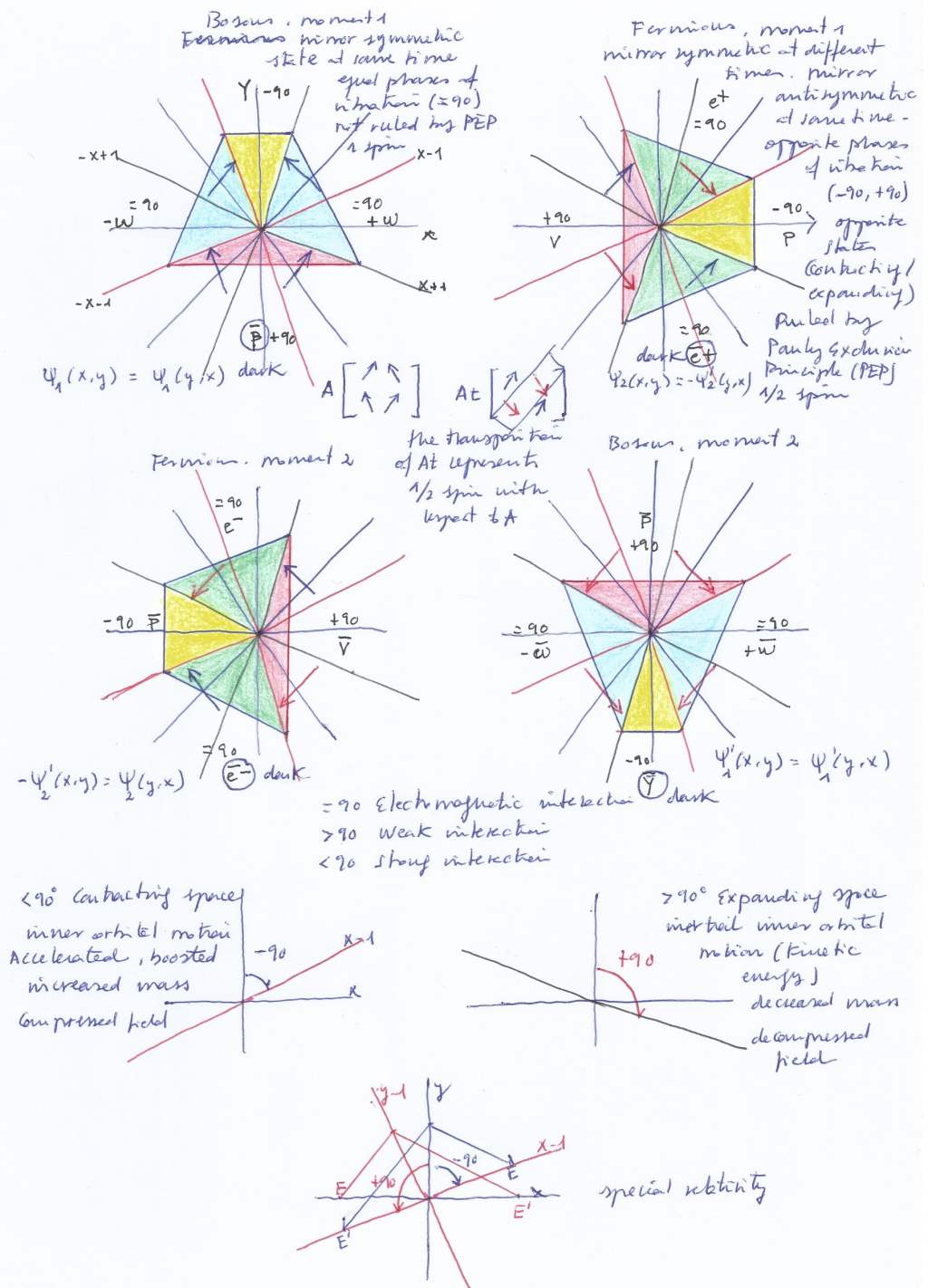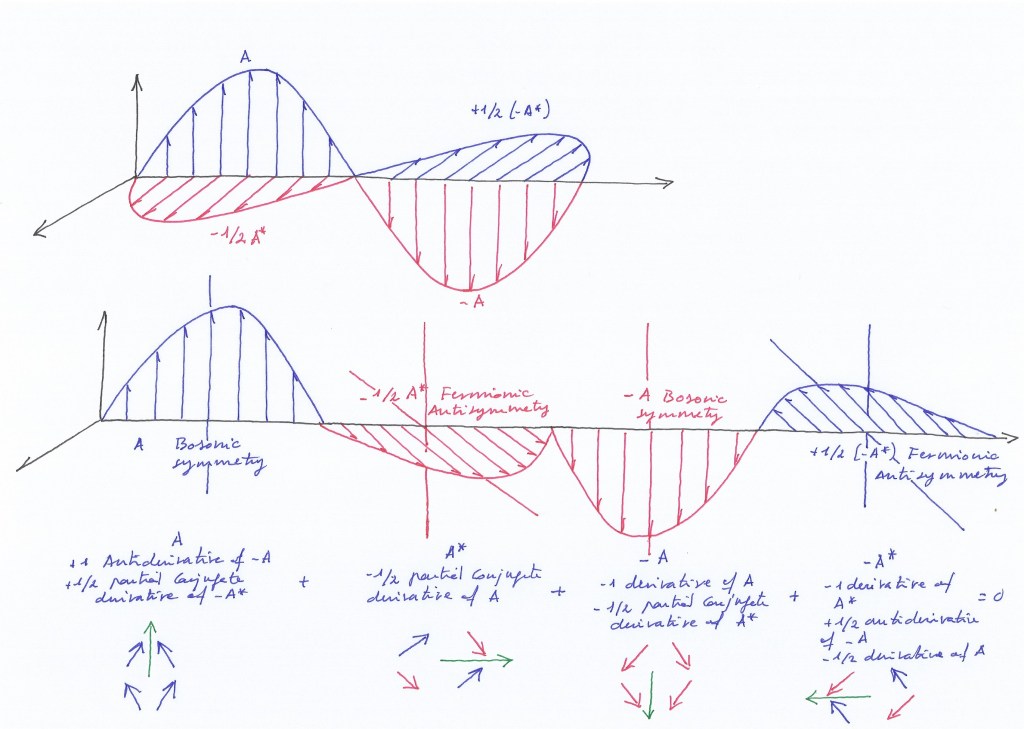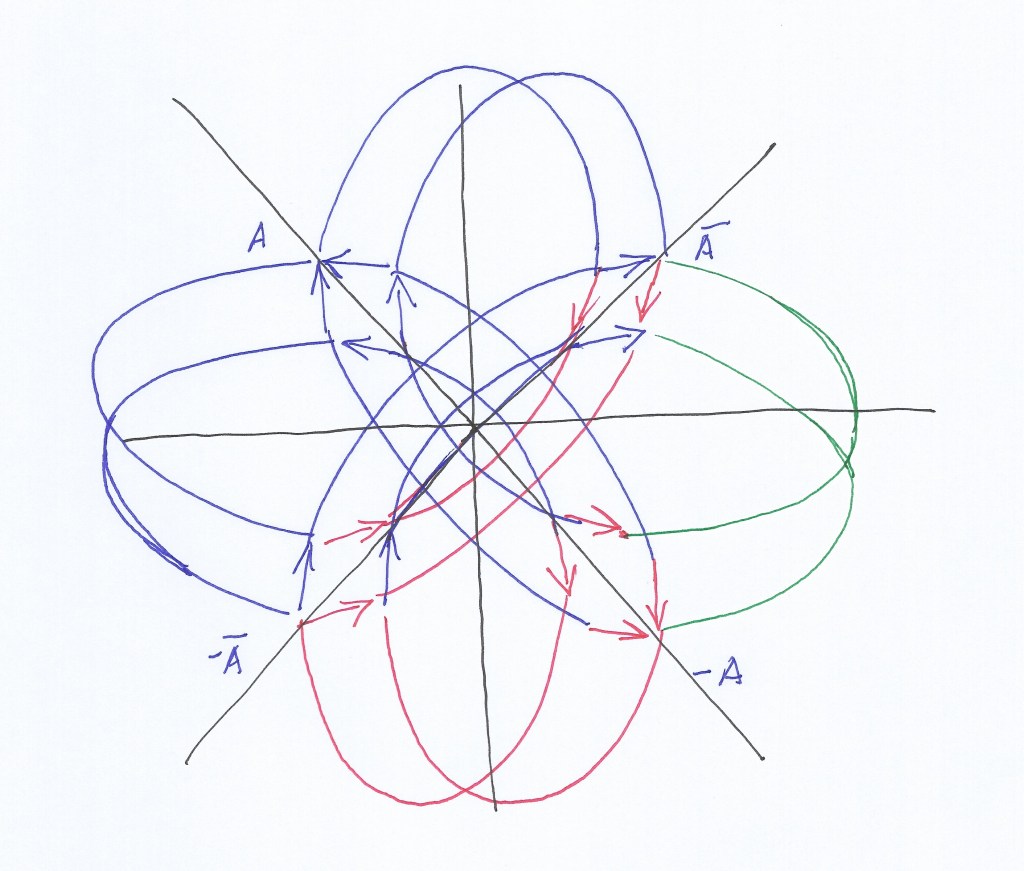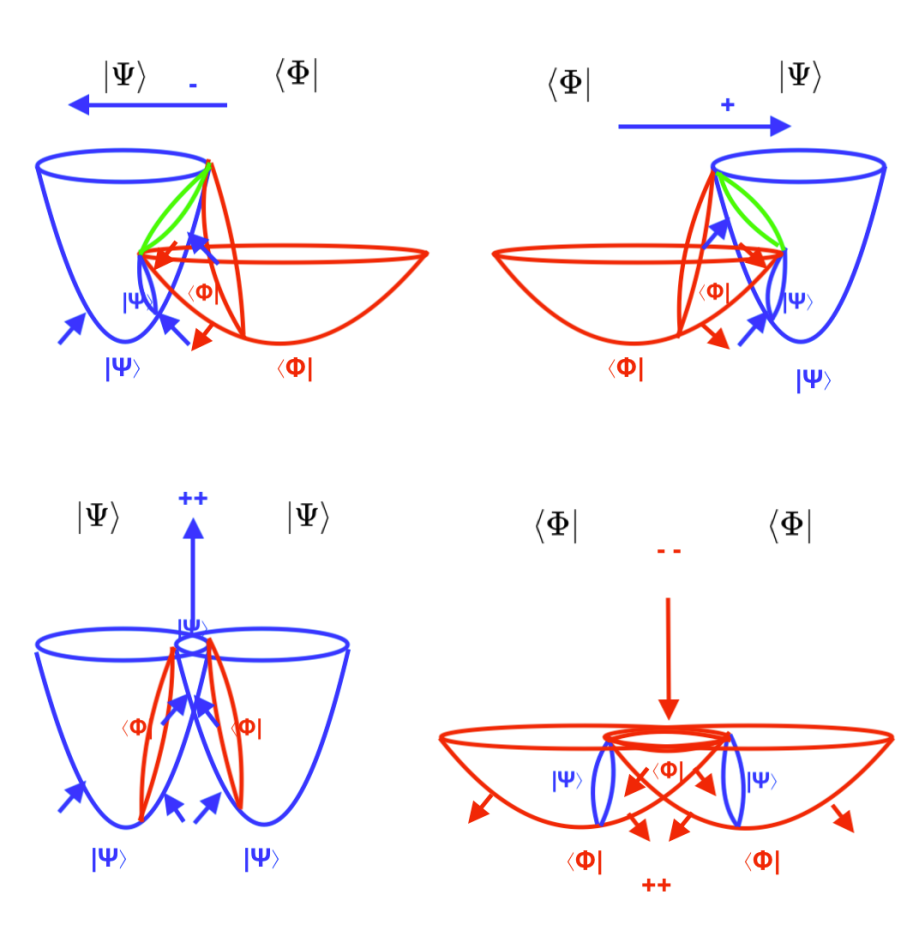He dibujado en esta figura el movimiento pendular, de derecha a izquierda, del campo (3) que se crea en la intersección de dos campos (1 y 2) que varían con fases opuestas: en la «posición 1» el campo 1 se expande y el 2 se contrae, y en la «posición 2» el campo 1 se contrae y el 2 se expande.
Al decir campos 1 y 2, pero me estoy refiriendo a los campos de gravedad curvados por las materias 1 y 2. En este blog pensamos que todos los campos de gravedad varían cíclicamente, y que se expanden y se contraen con una frecuencia que depende de la resistencia que la materia que los curva presente al paso del flujo gravitatorio. Al entrelazarse un campo de gravedad con otro campo de gravedad que varia con la misma fase (es decir los dos se expanden y se contraen al mismo tiempo) o con fases opuestas (cuando uno se expande el otro se contrae), crean en su intersección un campo nuevo (el que aparece dibujado como 3) cuyo desplazamiento produce lo que se ha venido a llamar corriente eléctrica o «electrón».
Es las figuras de este dibujo los campos de gravedad entrelazados varían con fases opuestas (al final de la entrada he puesto otras que varían con las mismas fases). Y eso da lugar a varias consecuencias:
1. La primera consecuencia es que el campo de la intersección (3) se desplaza hacia el lado de la materia cuyo campo de gravedad está contraído. La física actual explica la atracción de los «electrones» de una materia por otra en base a que ésta tendría mayor «electronegatividad» que la otra, siendo la electronegatividad una propiedad de la materia en virtud de la cuál atrae hacia sí o tiene «tender a atraer» a los «electrones», siendo estos considerados como subpartículas con carga eléctrica negativa. Para nosotros el «electrón» no es una subpartícula, es el espacio creado en la intersección de dos campos de gravedad que varían con fases opuestas. (Ese campo de la intersección podrá contener o no en su interior una materia, aquí lo hemos dibujado con una materia a la que hemos puesto número 3).
Cuando el campo de la intersección (el «electrón» con «carga negativa») se ha desplazado hacia la materia 2, en la posición 1 del dibujo, se dice que la materia 1 habría perdido un «electrón», adquiriendo mayor carga positiva, lo que llaman por oposición, un «protón».
Cuando los campos vuelven a variar, en la posición 2 del dibujo, ocurre lo contrario, el campo de la intersección el «electrón» (o «electrones compartidos»), se desplaza hacia la materia del campo 1 cuyo campo ahora se haya contraído. Y el del campo 2 ha perdido la carga negativa de su electrón, al estar ahora expandido, y por eso se dice que ha ganado un protón. Es es una situación dipolar, que tienes dos polos, uno negativo y otro positivo, que varían cíclicamente.
Cuando el electrón viaja en sentido contrario, (al variar de nuevo los campos), entonces se le llama positrón que sería un electrón de signo positivo, un anti-electrón. El hecho de que se le llame electrón – o positrón + cuando se dirige hacia un lado o hacia el otro no es más que una forma de designarlos para diferenciarlos.
2. Pero además, la intersección de los dos campos variables genera también otros dos campos que son los conos que he dibujado horizontalmente con órbitas en su interior dentro de cada campo 1 y 2. Estos campos horizontales no se desplazan como el campo 3, pero sí experimentan transformaciones a la vez que varían (se expanden o se contraen) los dos campos de gravedad entrelazados 1 y 2, y el campo 3 de la intersección se desplaza hacia un lado u otro. Estos otros campos horizontales se abren y se cierran y se inclinan hacia un lado o hacia otro de forma inversa a la variación del campo que los presiona desde arriba y de forma igual al campo que los presiona desde abajo.
Así en la «posición 1»: el campo 1 está expandido y el campo 2 está contraído. Por eso el cono horizontal de la izquierda, el que se encuentra dentro del campo 1, tiene unas órbitas de mayor longitud cuyo plano se inclina hacia la derecha; no está presionado por el extremo del campo 1 expandido ni por el extremo del campo 2 contraído; y el cono horizontal de la derecha, el que se encuentra en el campo 2, tiene menor longitud en sus órbitas porque está siendo presionado desde abajo por el campo 2 contraído y desde arriba por el 1 expandido. Su inclinación es también hacia la derecha.
En la «posición 2» ocurre lo contrario: El cono de la izquierda se ve presionado, reduciéndose la longitud de sus órbitas cuyo plano se inclina hacia la izquierda, mientras que el cono de la derecha ve reducida su presión, incrementando la longitud de sus órbitas cuyo plano se inclina hacia la izquierda.
Los conos horizontales no tienen la fuerza de arrastre que genera el movimiento del campo 3 (el electrón) al desplazarse hacia el campo contraído. Es decir no tienen carga eléctrica y entendemos que por eso se les atribuye carga neutra y que se corresponden con lo que la ciencia viene llamando «neutrón«. El neutrón sin embargo es medido por su masa y ahora explicaremos cómo puede ser si para nosotros es sólo un campo que varía.
Entonces vemos que lo que estamos describiendo como campos es lo mismo que la ciencia actual describe como subpartículas en el núcleo atómico, protones y neutrones y fuera del núcleo del átomo, electrones.
En la «radiación beta negativa» la física actual considera que un «neutrón» se «transforma» en un «electrón» y en un «protón». El protón se conserva en el núcleo emitiéndose dos partículas: el electrón y una partícula beta negativa.
En la «radiación beta positiva» la ciencia considera el «protón» se transforma en un «neutrón» y un «positrón» (electrón de carga positiva). Al positrón se le llama partícula beta positiva.
Para nosotros en la radiación beta negativa, en la posición 1 del dibujo, el campo 1 se expande y gana un protón de signo + (al alejarse de él el campo 3, el electrón); el campo 2 que se contrae es el que gana un electrón – (al acercarse hacia él el campo 3 produciendo una fuerza de arrastre dirigida hacia sí). El neutrón del campo 1 pierde la presión que tenía sobre sí incrementándose su volumen; y el neutrón del campo 2 reduce su volumen al sufrir la presión de los campos 1 y 2. Entonces la materia 2 (o su campo 2) gana un «electrón» y al mismo tiempo gana un «neutrón», y la materia 1 (o el campo 1) gana un protón (pierde un electrón) y pierde también un «neutrón».
Podríamos decir entonces que sólamente la materia que gana el electrón (la que se reduce en las reacciones redox) es la que gana el neutrón, mientras que la materia que pierde el electrón (la que se oxida en las reacciones redox) es la que pierde el neutrón, cuando las fases de variación de los campos de gravedad entrelazados son opuestas, es decir cuando hay dos polos opuestos en la molécula.
Hemos dicho que se pierde o se gana un neutrón, pero para nosotros el campo al que se está llamando «neutrón» sigue estando ahí, no se ha perdido ni se ha ganado en realidad, aunque si que se ha modificado; entendemos que si la ciencia está localizando al neutrón en base al peso, puesto que se dice que el neutrón sólo tiene masa y no carga eléctrica, entonces lo que estarán detectando es que la masa del protón de 1 ha perdido su peso y la del neutrón de 2 lo ha ganado en la misma proporción y que esto debe estarse interpretando en el sentido de que el neutrón de 1 se ha perdido y el de dos se ha ganado.
En el caso de la «posición dos» del dibujo ocurre todo lo contrario. La materia 1 que gana el «positrón» el electrón de signo negativo, es la que gana el neutrón, se aumenta la presión sobre el neutrón que hay en ese campo, y la materia de 2 que pierde el electrón que tenía pierde también presión en su neutrón, «pierde» el neutrón que tenía.
¿Que serán entonces las radiaciones beta positiva y beta negativa? Nosotros suponemos que esas radiaciones son creadas por las transformaciones de los campos a los que se conocen como «neutrones». La radiación beta positiva se creará por el campo que gana el positrón, puesto que el aumento de presión de su neutrón genera más energía, y la radiación beta negativa será la generada por el neutrón opuesto cuando el campo de gravedad en que se encuentre se contraiga atrayendo hacia sí al campo de la intersección, es decir ganando el electrón -.
Lo mismo puede decirse de los decaimientos beta positivo y beta negativo, que serán opuestos a las radiaciones beta negativa y beta positiva emitidas por el neutrón de la materia cuyo campo esté entrelazado al de otra y los dos varíen con fases opuestas.
Así la ganancia de presión del neutrón de la materia 2, en la «posición 1 del dibujo», al ganar un electrón emitirá radiación beta negativa y la pérdida de presión del neutrón del campo en la «posición 1″ del dibujo» implicará un decaimiento beta positivo de su energía al ganar un protón.
Y al contrario, la ganancia de presión del neutrón de la materia 1, en la «posición 2 del dibujo», al contraerse su campo y ganar para este un «positrón» emitirá ahora radiación beta positiva, y la pérdida de presión del neutrón del campo 2 en la «posición 2» del dibujo implicará un decaimiento beta negativo de su energía al ganar un protón.
La ciencia actual considera que los neutrones están en el interior del núcleo, dentro de la materia, y apara justificar las aparentes pérdidas de energía de los «núcleos» sin contradecir el principio de la conservación de la energía, ha necesitado inventar una subpartícula más, ideada por Pauli en el siglo pasado, además de los electrones protones y neutrones. Es lo que se ha llamado «neutrino«, que para nosotros es realmente el mismo neutrón considerado como campo y localizado de la forma que hemos explicado, cuando este experimenta la pérdida de presión que tenía sobre sí. Recientemente la ciencia detectó los «neutrinos» predichos por Pauli, pero para nosotros lo que se está detectando como neutrino no es una subpartícula, tiene que ser la consecuencia de la variación de presión del campo al que llamamos «neutrón».
Con respecto a la radiación y al decaimiento Alfa y Gamma, el mecanismo de explicación que proponemos aquí es el mismo, sólo que en este caso las fases de variación de los campos de gravedad entrelazados será igual, es decir, ahora los dos campos entrelazados se expanden y se contaren al mismo tiempo.
En la radiación alfa se dice actualmente por la ciencia que se emite una «partícula alfa» que está compuesta por dos protones y dos neutrones, así que el núcleo pierde dos protones y dos neutrones. Y al formarse un nuevo núcleo este decae a un estado más fundamental, con el mismo número de protones y neutrones que tenía, emitiendo ondas electromagnéticas. En la radiación y decaimiento gamma se dice que no hay transformación de protones y neutrones sino que se pierde el exceso de energía nuclear que había acumulada, emitiéndose un fotón.
Para nosotros no puede haber diferencia entre forma de generar las radiaciones y decaimientos alfa y gamma, el mecanismo tiene que ser el mismo: los dos campos entrelazados se contraen y el espacio de la intersección aumenta su presión a la vez que asciende hacia arriba. (Puede verse en el dibujo de más abajo). La presión ascendente genera el fotón. Los dos «neutrones» de cada campo, los conos horizontales dentro de cada campo, dejan de ser presionados y aumentan su área. De modo que cuando el campo de la intersección adquiere presión, con los dos campos de gravedad contraídos, los dos neutrones pierden presión, en el lenguaje actual se diría que los dos átomos entrelazados, cuando están emitiendo el fotón pierden cada uno un protón (puesto que los campos ahora no están expandidos) y pierden también cada uno un neutrón (ya que estos pierden su presión).
Pero la energía del campo de la intersección comienza a perderse, a decaer, cuando los dos campos de gravedad entrelazados se expanden, disminuyendo la presión que ejercían sobre el campo de la intersección y descendiendo este hacia abajo. En este caso se puede pensar que el decaimiento de energía tiene lugar porque se ha emitido un fotón de modo que la pérdida de energía del sistema será igual a la cantidad de energía liberada en el fotón. Pero para nosotros no es así.
También se podría pensar que el sistema pierde energía porque para generar el fotón los dos neutrones tuvieron que transformarse en neutrinos (puesto que en el momento de liberarse el fotón, con los dos campos completamente contrañidos) los espacios a que llamamos «neutrones» están despresurizados y podrían ser identificados de la misma forma que vimos antes como tales neutrinos. Y al decaer el sistema, al expandirse de nuevo los dos campos, los dos neutrones van a experimentar de nuevo el incremento de presión. Es decir, la liberación del fotón o de la radiación electromagnética se traduce en una ganancia de neutrones, o si se quiere en una transformación de los neutrinos en neutrones. Pero para nosotros esto no es lo que explica la pérdida aparente de energía del sistema.
Para nosotros, la aparente pérdida de energía del núcleo al emitirse el fotón habría que buscarla en la cara inversa de la curvatura del campo de la intersección. Esta curvatura invertida, se encuentra fuera de los dos campos de gravedad, en la cara convexa de su curvatura, en la parte intersectada de ambos. Es ahí donde se producirá una fuerza de presión proporcional al decaimiento de energía que experimenta la intersección en la cara cóncava de los dos campos cuando estos se expanden a la vez. Y esta fuerza de presión invertida tendrá una dirección opuesta a la dirección del flujo gravitatorio, es decir será un antifotón, una fuerza propiamente antigravitatoria creada por la misma gravedad al variar de este modo, siendo este proceso cíclico.
Dado que entre cada expansión y cada contracción se pierde un lapso de tiempo, las fases de variación se van invirtiendo progresivamente con el paso del tiempo. Y parece lógico pensar que fases iguales terminen siendo fases opuestas para después volver a igualarse nuevamente en un proceso también cíclico aunque mucho más lento. Dado que las fases de variación determinan la configuración electrónica de la materia estas variaciones indican que la materia se va transformando de forma paulatina y cíclica.

